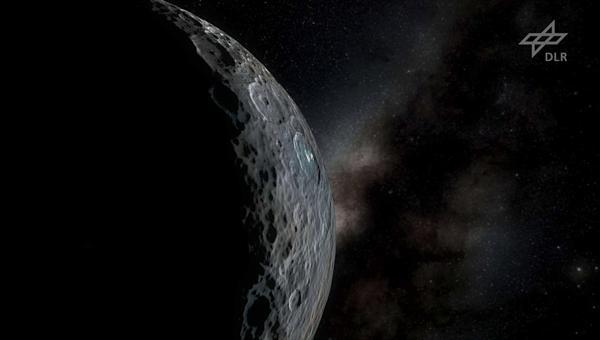Video: Flying over the craters of dwarf planet Ceres

Your consent to the storage of data ('cookies') is required for the playback of this video on Quickchannel.com. You can view and change your current data storage settings at any time under privacy.
NASA/JPL-Caltech/UCLA/MPS/DLR/IDA.
The dwarf planet Ceres would be quite an uncomfortable place if one were to actually stand on its surface – with a rather 'chilly' temperature of minus 60 degrees Celsius by day, which gets colder during the night. Hard, frozen ground and craters spanning kilometres – in all shapes and sizes. This is Ceres. In the vacuum, the visitor would be surrounded by silence – although, when out for a stroll, the crunching of the ground underneath would certainly be audible. So getting a closer look at Ceres from the Dawn spacecraft is much more comfortable. Planetary researchers at the German Aerospace Center (Deutsches Zentrum für Luft- und Raumfahrt; DLR) have created a film with camera data acquired by the Dawn orbiter while at a distance of 1450 kilometres from the dwarf planet’s surface. The film offers a several-minute flight over the varied crater world and its mountain Ahuna Mons. "The simulated overflight shows the wide range of crater shapes that we have encountered on Ceres. The viewer can observe the sheer walls of the crater Occator, which come close to the north face of the Eiger, but also Dantu and Yalode, where the craters are a lot flatter," explains Ralf Jaumann, planetary researcher at DLR and a scientist for the US Dawn mission.
A surface – young and old
Scientists from the To the Institute's website used 2350 images to generate a realistic view of the icy dwarf planet. As part of this, contrast-enhanced real colours show the variety of materials found on the surface. Regions containing clay appear brownish: "On Earth, we would be able to make, for example, brick or terracotta, from that." The blue areas represent a surface covered with younger, fresher material. There, surfaces with sinks, showing flow and fault structures, are depicted. The Haulani crater, for example, looks fairly recent – blue and brown regions merge there. "It could either be that material was melted there through impact or that material has penetrated through from below." Under the crust, which could be up to 100 kilometres thick, it could be much softer: "The salts that are probably present on Ceres destabilise the ice and create a tough mush in the interior."
Even the flanks of Ahuna Mons, a mountain approximately 6000 metres high, are covered with fresh material. "The material found here could be similar to that of the impact craters, where the interior of Ceres has made its way to the outside." However, the interpretation of the camera images is currently the subject of many discussions among the team of scientists in the Dawn mission. "We have many theories, but as yet no evidence," says Jaumann.
3D elevation model
With the Dawn spacecraft, planetary researchers have been able to investigate and explore two celestial bodies during one mission for the first time. Following a visit to the asteroid Vesta, the spacecraft is currently orbiting the dwarf planet Ceres. On 6 March 2015, Dawn reached its second, icy mission target, and has since been circling Ceres in ever-smaller orbits. In the meantime, from a distance of 385 kilometres above Ceres' surface, Dawn is sending images to Earth. "This data will also be used to compute a three dimensional elevation model of the surface," explains Jaumann. "Then, we will be able to fly over the different craters and regions in our films in even closer proximity."
The mission
The Dawn mission is managed by NASA's Jet Propulsion Laboratory (JPL) in Pasadena, which is a division of the California Institute of Technology. The University of California, Los Angeles, is responsible for overall Dawn mission science. The Framing Camera system on the spacecraft was developed and built under the leadership of the Max Planck Institute for Solar System Research in Göttingen, Germany, in collaboration with the DLR Institute of Planetary Research in Berlin and the Institute of Computer and Communication Network Engineering in Braunschweig. The Framing Camera project is funded by the Max Planck Society, DLR, and NASA/JPL.
